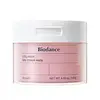What's inside
What's inside
 Key Ingredients
Key Ingredients

No key ingredients
 Benefits
Benefits

 Ingredients Side-by-side
Ingredients Side-by-side

Water
Skin ConditioningButylene Glycol
Humectant1,2-Hexanediol
Skin ConditioningLactobacillus
Skin ConditioningSea Water
HumectantPolyglyceryl-10 Laurate
Skin ConditioningArginine
MaskingAllantoin
Skin ConditioningCarbomer
Emulsion StabilisingEthylhexylglycerin
Skin ConditioningXanthan Gum
EmulsifyingSodium Polyacrylate
AbsorbentFicus Indica Leaf Extract
Skin ConditioningMethyl Diisopropyl Propionamide
MaskingHouttuynia Cordata Extract
Skin ConditioningSpirulina Maxima Extract
SmoothingUlmus Davidiana Root Extract
Skin ConditioningMaltodextrin
AbsorbentHydrolyzed Roe Extract
HumectantJania Rubens Extract
Skin ConditioningSea Silt Extract
Skin ConditioningMacrocystis Pyrifera Extract
Skin ConditioningWater, Butylene Glycol, 1,2-Hexanediol, Lactobacillus, Sea Water, Polyglyceryl-10 Laurate, Arginine, Allantoin, Carbomer, Ethylhexylglycerin, Xanthan Gum, Sodium Polyacrylate, Ficus Indica Leaf Extract, Methyl Diisopropyl Propionamide, Houttuynia Cordata Extract, Spirulina Maxima Extract, Ulmus Davidiana Root Extract, Maltodextrin, Hydrolyzed Roe Extract, Jania Rubens Extract, Sea Silt Extract, Macrocystis Pyrifera Extract
Water
Skin ConditioningCollagen Water
HumectantButylene Glycol
Humectant1,2-Hexanediol
Skin ConditioningPolyglyceryl-10 Laurate
Skin ConditioningGlycerin
HumectantEthylhexylglycerin
Skin ConditioningArginine
MaskingAllantoin
Skin ConditioningCarbomer
Emulsion StabilisingXanthan Gum
EmulsifyingDisodium EDTA
Sodium Polyacrylate
AbsorbentCyanocobalamin
Skin ConditioningPalmitoyl Tripeptide-5
Skin ConditioningHydrolyzed Hyaluronic Acid
HumectantCollagen Extract
Skin ConditioningHydrolyzed Elastin
EmollientGalactomyces Ferment Filtrate
HumectantHyaluronic Acid
HumectantSh-Polypeptide-22
Skin ConditioningSh-Oligopeptide-1
Skin ConditioningSh-Polypeptide-1
Skin ConditioningSh-Oligopeptide-2
Skin ConditioningSh-Polypeptide-3
Skin ConditioningWater, Collagen Water, Butylene Glycol, 1,2-Hexanediol, Polyglyceryl-10 Laurate, Glycerin, Ethylhexylglycerin, Arginine, Allantoin, Carbomer, Xanthan Gum, Disodium EDTA, Sodium Polyacrylate, Cyanocobalamin, Palmitoyl Tripeptide-5, Hydrolyzed Hyaluronic Acid, Collagen Extract, Hydrolyzed Elastin, Galactomyces Ferment Filtrate, Hyaluronic Acid, Sh-Polypeptide-22, Sh-Oligopeptide-1, Sh-Polypeptide-1, Sh-Oligopeptide-2, Sh-Polypeptide-3
 Reviews
Reviews

Ingredients Explained
These ingredients are found in both products.
Ingredients higher up in an ingredient list are typically present in a larger amount.
1,2-Hexanediol is a synthetic liquid and another multi-functional powerhouse.
It is a:
- Humectant, drawing moisture into the skin
- Emollient, helping to soften skin
- Solvent, dispersing and stabilizing formulas
- Preservative booster, enhancing the antimicrobial activity of other preservatives
Allantoin is a soothing ingredient known for its protective and moisturizingg properties. Because of this, it is often added to products with strong active ingredients.
Studies show higher concentrations of this ingredient can promote wound healing.
Though it can be derived from the comfrey plant, allantoin is produced synthetically for cosmetic products to ensure purity.
Learn more about AllantoinArginine is an amino acid that is important for human development. Your body uses is it to produce hair keratin and skin collagen.
As a cosmetic ingredient, Arginine has antioxidant properties and can also help repair damaged skin. This ingredient is derived either synthetically or from animals.
Arginine isn't fungal acne safe when used in the presence of other lipids (fats, fatty acids, oils, esters, etc). Oils and fats occur naturally within the skin, so take caution when using Arginine if you're prone to fungal acne.
Learn more about ArginineButylene Glycol (or BG) is used within cosmetic products for a few different reasons:
Overall, Butylene Glycol is a safe and well-rounded ingredient that works well with other ingredients.
Though this ingredient works well with most skin types, some people with sensitive skin may experience a reaction such as allergic rashes, closed comedones, or itchiness.
Learn more about Butylene GlycolCarbomer is a polymer of acrylic acid. Its main role is to create a gel consistency.
A high amount of carbomer can cause pilling or balling up of products. Don't worry, most products contain 1% or less of carbomer.
Ethylhexylglycerin (we can't pronounce this either) is commonly used as a preservative and skin softener. It is derived from glyceryl.
You might see Ethylhexylglycerin often paired with other preservatives such as phenoxyethanol. Ethylhexylglycerin has been found to increase the effectiveness of these other preservatives.
Polyglyceryl-10 Laurate is an ester of lauric acid and Polyglycerin-10.
Polyglyceryl-10 Laurate is a cleansing agent and emulsifier. It helps gather dirt, oil, and other pollutants to be rinsed away. As an emulsifier, it helps prevent ingredients from separating, such as oil and water.
Polyglyceryl-10 Laurate may not be fungal acne safe.
Learn more about Polyglyceryl-10 LaurateSodium Polyacrylate is the sodium salt of polyacrylic acid. It is used as an absorber, emollient, and stabilizer.
This ingredient is a super-absorbent polymer - meaning it can absorb 100 to 1000 times its mass in water. As an emollient, Sodium Polyacrylate helps soften and soothe skin. Emollients work by creating a barrier to trap moisture in. This helps keep your skin hydrated.
Water. It's the most common cosmetic ingredient of all. You'll usually see it at the top of ingredient lists, meaning that it makes up the largest part of the product.
So why is it so popular? Water most often acts as a solvent - this means that it helps dissolve other ingredients into the formulation.
You'll also recognize water as that liquid we all need to stay alive. If you see this, drink a glass of water. Stay hydrated!
Learn more about WaterXanthan gum is used as a stabilizer and thickener within cosmetic products. It helps give products a sticky, thick feeling - preventing them from being too runny.
On the technical side of things, xanthan gum is a polysaccharide - a combination consisting of multiple sugar molecules bonded together.
Xanthan gum is a pretty common and great ingredient. It is a natural, non-toxic, non-irritating ingredient that is also commonly used in food products.
Learn more about Xanthan Gum